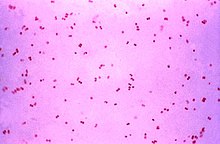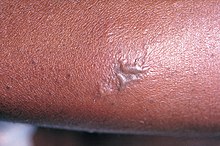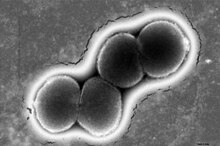

| Gonococcemia | |
|---|---|
| Other names | Disseminated gonococcal infection[1] |
 | |
| Neisseria gonorrhoeae | |
| Specialty | Infectious diseases |
| Symptoms | Fever, multijoint pain, hemorrhagic pustules |
| Complications | Rarely leads to meningitis and endocarditis |
| Causes | Neisseria gonorrhoeae infection |
| Risk factors | unprotected sex, female sex |
| Diagnostic method | Nucleic Acid Amplification Techniques (NAAT) |
| Treatment | Cephalosporins or Fluoroquinolones |
Gonococcemia (also known as "Disseminated gonococcal infection"[1]) is a rare complication of mucosal Neisseria gonorrhoeae infection, or Gonorrhea, that occurs when the bacteria invade the bloodstream.[2] It is characterized by fever, tender hemorrhagic pustules on the extremities or the trunk, migratory polyarthritis, and tenosynovitis.[3] It also rarely leads to endocarditis and meningitis.[4] This condition occurs in 0.5-3% of individuals with gonorrhea, and it usually presents 2–3 weeks after acquiring the infection.[5] Risk factors include female sex, sexual promiscuity, and infection with resistant strains of Neisseria gonorrhoeae. This condition is treated with cephalosporin and fluoroquinolone antibiotics.[4]

Neisseria gonorrhoeae is a gram negative diplococcus (also referred to as "Gonococcus") and a pathogenic bacteria.[2] In 2019, there were 616,392 reported cases of gonorrhea in the United States, with an overall increased rate 5.7% from 2018 to 2019.[6] Among those approximately 600,000 cases, it is estimated that 0.5-3% of gonorrheal infections result in gonococcemia. This condition is more common in women, affecting approximately 2.3-3% of women with gonorrhea and 0.4-0.7% of men.[4] This discrepancy is explained by increased incidence of silent gonorrheal infections in females and an increased rate of transmission to females that have sexual intercourse with infected males.[5] Gonococcemia also occurs more frequently in pregnant women, those with recent menstruation, and those with IUDs.[5]
Treatment typically consists of cephalosporin and fluoroquinolone antibiotics.[4] Gonococcemia is typically treated with intravenous or intramuscular cephalosporin antibiotics.[5] Approximately 10-30% of gonorrheal infections present with a co-infection of chlamydia, so it is common to add a one-time dose of oral azithromycinordoxycycline for coverage of Chlamydia trachomatis.[5] Bacterial resistance to antibiotics is increasingly common in Neisseria gonorrhoeae, so it is often advised to check susceptibility of the bacterial culture and then adjust the antibiotic therapy as needed.[4]
Neisseria gonorrhoeae is transmitted during sexual contact with an infected individual. The bacteria invade the non-ciliated columnar epithelium of the urogenital tract, oral mucosa, or anal mucosa following exposure.[2] Invasion of the host cells is made possible due to virulence factors such as Pili, LOS, Opa, and others.[2] Similarly, these virulence factors can be used for avoiding the host immune system, which may explain prolonged infection, bacterial resistance, and gonococcemia.[3]
